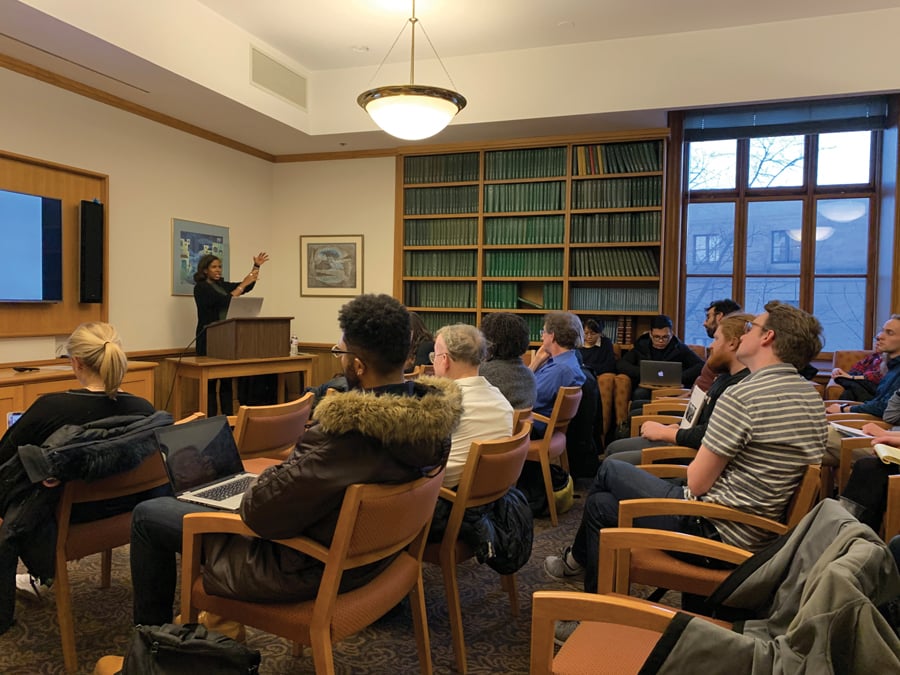University of Illinois Prof. Hogarth talks eugenics and its roots in slavery
Jason Beeferman/The Daily Northwestern
Professor Rana Hogarth gives a talk on her new research in the Hagstrum Room of University Hall on Monday. Her lecture argued that the eugenics movement was motivated by the views of the slavery era.
February 11, 2020
University of Illinois Prof. Rana Hogarth discussed her new research into eugenicist movements in University Hall on Monday. Her talk argued that — contrary to common views of American history — eugenics is actually a continuation of the views of the slavery era, rather than a seperate movement.
Through her talk, Hogarth presented the idea that eugenics was used to affirm prexisting beliefs that originated in the slavery era.
“Eugenic-era race crossing studies owed a lot of their creation to old ideas about race mixing from the era of slavery,” Hogarth said. “Most people think of eugenics as this forward, new genetic science, which it is, but they were actually taking old ideas and repackaging them with new science.”
Hogarth’s research specifically focused on two early 20th century studies of Charles Davenport, a leader of the eugenics movement in the United States. The two studies examined mixed-race populations in the Caribbean.
The lecture, titled, “Legacies of Slavery in the Era of Eugenics: Charles B. Davenport’s Race-Crossing Studies,” was part of the Klopsteg Lecture Series, which aims to present popular understandings of science for the general public.
Hogarth discussed multiple aspects of Davenport’s experiments, including his reluctance to acknowledge the role of white men in the existence of people identifying as mixed-race in the first place. Davenport, for example, would describe his subjects as “fair skinned babies from dark mothers,” without ever mentioning the role of a white father.
“Davenport attempted to craft a narrative that played into white perceptions about black female sexuality, that only suddenly subtly implicated white men,” Hogarth said.
Ken Alder is the founding director of the Science in Human Culture program, which hosts the lecture series. Alder said the talk itself was “fabulous.”
“This particular aspect of (eugenics) was a sort of scientific justification for something that Americans already wanted to do,” Alder said.
Raina Bhagat is a first year PhD student in comparative literary studies who attended the lecture. Bhagat said she was especially intrigued by Hogart’s discussion of how eugenicists sought to use hair as an indication of ancestry.
“It felt like a very contemporary link of this research that centered at the beginning of the 20th century, to here in the 21st century (with) the idea that hair comes in different shapes and sizes,” Bhagat said.
Bhagat was referring to a discovery Hogarth made while digging through the archives of the American Philosophical Society in Philadelphia.
After asking for all the materials relating to Davenport, she found a tiny manila envelope listed under the category of “Family Histories.” When Hogarth opened the envelope, to her surprise, human samples of hair fell out.
Though the hair was unexpected, it was definitely fascinating, Hogarth said.
“When I went to the archives, I was like, this is really gross, but this is totally going into my research,” Hogarth said.
To Hogarth, the human hair samples were more than an unusual find.
“To me, seeing something like a human article, a part of somebody’s body in this archive tells me that this is about reading peoples’ bodies,” Hogarth said. “This is about science, what science can tell us about somebody’s potential or about someone’s ancestry by literally studying something as minute your hair. That to me is very telling.”
Email: [email protected]
Related Stories:
–Brainstorm: Why does Social Darwinism still exist?
–Satoshi Kanazawa, whose work has been criticized as racist, is facing mounting backlash from the Northwestern community


